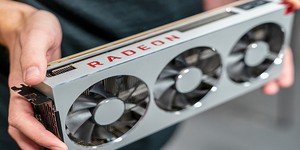AMD has announced a trio of new products based around its Fiji, Polaris, and Vega graphics processors, but they're most certainly not aimed at enthusiasts and gamers: Instead, Radeon Instinct is targeted very firmly at the deep learning and artificial intelligence markets.
AMD's Radeon Instinct family launches with three individual models: the MI6 is a Polaris-based 'inference accelerator' designed to boost the performance of deep learning and artificial intelligence systems, offering 5.7 teraflops of floating point compute and 224GB/s of memory bandwidth to 16GB of VRAM in a passively-cooled full-length board drawing less than 150W of power; the MI8 ups the performance stakes with a Fiji GPU offering 8.2 teraflops and 512GB/s of memory bandwidth to 4GB of High-Bandwidth Memory (HBM) VRAM with a 175W power draw, but a shift to active rather than passive cooling means it's a half-length card; finally, the MI25 is a full-length accelerator based around AMD's next-generation Vega GPU which draws around 300W yet is somehow passively cooled, and includes additional hardware designed to boost the training performance of AI systems.
With the MI25 being the most exciting of the three devices, it's a shame then to see that AMD is keeping the bulk of the details under wraps. While it's to be expected that the part will include HBM2 VRAM this is not confirmed, and neither has AMD offered full specifications. Instead, its announcement presentation simply described the part as offering 'high bandwidth cache and controller' as well as '2x packed math' performance with the promise of 25 teraflops of single-precision compute translating to around a doubling of real-world performance in deep learning tasks compared with the Maxwell-based Titan X. The MI25 will, AMD has further confirmed, include additional hardware in the form of an 'NCU' the details of which have not been disclosed, but which can reasonably be expected to take the form of an accelerator similar in concept to Google's TensorFlow Processing Unit (TPU) technology.
'We’ve invested heavily in high performance graphics and high performance compute, and now we're poised for success in combining these two investments to create solutions,' claimed AMD's Jason Evangelho of the announcement. 'We're the only company in the industry who can enable true high-performance heterogeneous applications to solve the problem of evaluating and acting on all this data. But we’re also thinking about how we can add value to the entire ecosystem. We are doing that by embracing open software computing platforms, and open interconnects.'
More details on the Radeon Instinct family, which targets markets from autonomous vehicles to financial services, where they will go head-to-head with accelerators from rivals Nvidia and Intel, can be found on AMD's official website.
AMD's Radeon Instinct family launches with three individual models: the MI6 is a Polaris-based 'inference accelerator' designed to boost the performance of deep learning and artificial intelligence systems, offering 5.7 teraflops of floating point compute and 224GB/s of memory bandwidth to 16GB of VRAM in a passively-cooled full-length board drawing less than 150W of power; the MI8 ups the performance stakes with a Fiji GPU offering 8.2 teraflops and 512GB/s of memory bandwidth to 4GB of High-Bandwidth Memory (HBM) VRAM with a 175W power draw, but a shift to active rather than passive cooling means it's a half-length card; finally, the MI25 is a full-length accelerator based around AMD's next-generation Vega GPU which draws around 300W yet is somehow passively cooled, and includes additional hardware designed to boost the training performance of AI systems.
With the MI25 being the most exciting of the three devices, it's a shame then to see that AMD is keeping the bulk of the details under wraps. While it's to be expected that the part will include HBM2 VRAM this is not confirmed, and neither has AMD offered full specifications. Instead, its announcement presentation simply described the part as offering 'high bandwidth cache and controller' as well as '2x packed math' performance with the promise of 25 teraflops of single-precision compute translating to around a doubling of real-world performance in deep learning tasks compared with the Maxwell-based Titan X. The MI25 will, AMD has further confirmed, include additional hardware in the form of an 'NCU' the details of which have not been disclosed, but which can reasonably be expected to take the form of an accelerator similar in concept to Google's TensorFlow Processing Unit (TPU) technology.
'We’ve invested heavily in high performance graphics and high performance compute, and now we're poised for success in combining these two investments to create solutions,' claimed AMD's Jason Evangelho of the announcement. 'We're the only company in the industry who can enable true high-performance heterogeneous applications to solve the problem of evaluating and acting on all this data. But we’re also thinking about how we can add value to the entire ecosystem. We are doing that by embracing open software computing platforms, and open interconnects.'
More details on the Radeon Instinct family, which targets markets from autonomous vehicles to financial services, where they will go head-to-head with accelerators from rivals Nvidia and Intel, can be found on AMD's official website.

MSI MPG Velox 100R Chassis Review
October 14 2021 | 15:04









Want to comment? Please log in.